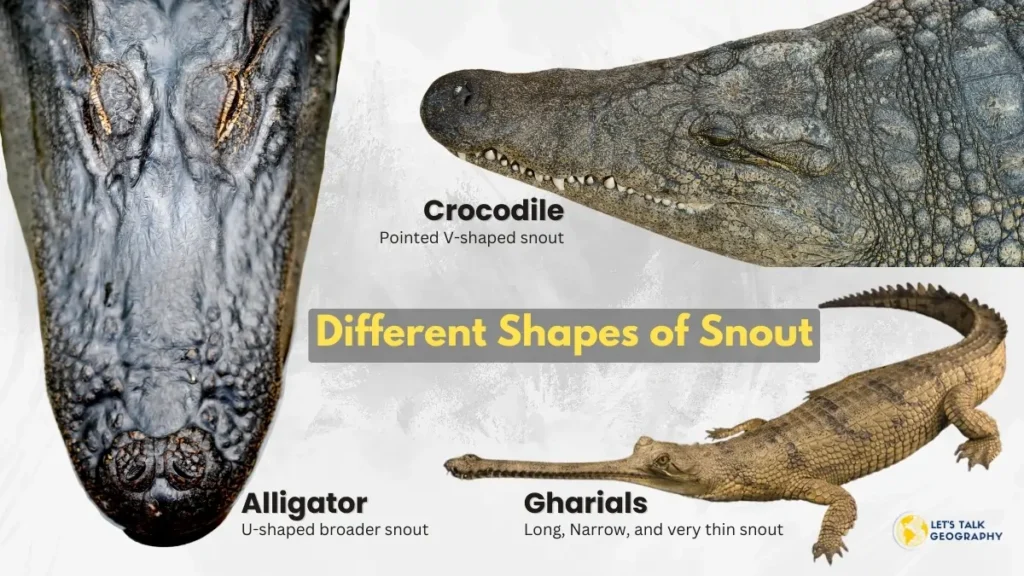Introduction:
When the question arises about the world of reptiles, there are a lot of creatures and animals that are fascinating enough, like crocodiles, alligators, and gharials. These primitive animals walked on the earth for many years and evolved specific features that make them different. Even though they share similarities due to their common ancestry, there are particular differences in their livelihood, physical specifications, behaviors, and conservation conditions. Let’s learn about the differences between crocodile alligator and ghariali, unique and essential for their conservation and the safety of their natural ecosystem.
Overview of The Three Reptiles:
Crocodiles: They are the most found among the three, inhibiting various regions across Africa, Australia, southeast Asia, and the Americas. They are renowned for their V-shaped snouts and assertive, aggressive behavior; crocodiles are mainly found in freshwater and saltwater ambiance. Crocodiles are seen soaking in the sun close to water bodies as it is required to maintain their body temperature.
Alligators: These are mainly found in the southeastern US and China. They mostly look for freshwater ecosystems like ponds, marshes, and rivers. Known for their border, Ushapd snouts, alligators and are generally less rough than crocodiles. Their food habits mainly consist of birds, fish, and other mammals.
Gharials: Also known as gavials, are present in the Indian subcontinent and are mainly found in rivers with deep and fast-moving waters. They are recognized by their long, narrow snouts filled with numerous sharp teeth, which are total. They are utilized mainly for catching fish.
Differences Between Crocodile Alligator and Gharial:
| Crocodiles | Alligators | Gharials | |
| Habitat and Distribution | Mostly Freshwater, along with saltwater habitat | Freshwater habitats like ponds, lakes, rivers, etc. | Mostly Freshwater rivers |
| Physical Characteristics | Pointed V-shaped snout | U-shaped broader snout | long, narrow, and very thin snout |
| Reproduction And Lifespan | Lifespan of 50 to 75 years | Lifespan of 35 to 50 years | In captivity, around 29 years, and in the wild, around 60 years |
◉ Habitat and Distribution:
Crocodiles:
- Regions where they are found (Africa, Australia, Southeast Asia, and the Americas): Crocodiles primarily inhabit the lowland, humid tropics of the Northern and Southern Hemispheres. The “true crocodiles” (family Crocodylidae) are found across various regions, including the majority of Africa south of the Sahara, Madagascar, India, Sri Lanka, Southeast Asia, the East Indies, northern Australia, Mexico and Central America, the West Indies, and northern South America.
- Preferred habitats (rivers, lakes, wetlands, and even saltwater): Crocodiles are mainly carnivorous and found in freshwater habitats, such as rivers, lakes, wetlands, and sometimes blackish water. Unlike alligators, they are primarily equatorial animals, which are very responsive to cold.
Alligators:
- Regions where they are found (Primarily in the southeastern United States and China): The American alligator (Alligator mississippiensis) is the larger of the two species and is native to the southeastern United States. Juveniles are black with yellow banding, while adults are typically brownish. The Chinese alligator (A. sinensis) is a smaller, lesser-known species found in the Yangtze River region of China.
- Preferred habitats (freshwater environments like ponds, marshes, and rivers): Alligators are carnivorous and typically reside along the edges of permanent water bodies like lakes, swamps, and rivers. They often dig burrows to rest and escape extreme weather conditions.
Gharials:
- Regions where they are found (primarily in the Indian subcontinent): Gavials once inhabited riverine environments across South Asia, from Pakistan to Myanmar (Burma). Their geographic availability is restricted to a few widely scattered habitats in northern India, Nepal, and Bangladesh.
- Preferred habitats (river systems with deep, fast-moving waters): They are found mainly under deep, fast-moving rivers with many sandbanks needed for basking and nesting.
◉ Physical Characteristics:
Crocodiles:
- Snout shape (V-shaped, pointed): All crocodiles possess a relatively long snout or muzzle, which can vary significantly in shape and proportion.
- Size and weight variations: It is about 7 meters long and weighs over 1200kg. Some fossil specifications, such as Deinosuchus and Sarcosuchus, may have measured between 10 and 12 meters (33 and 40 feet) long. In contrast, the smallest species, the smooth-fronted caiman (Paleosuchus) and the dwarf crocodile (Osteolaemus tetraspis) reach about 1.7 meters (about 6 feet) in length as adults.
- Coloration and skin texture: The scales covering most of the body are typically arranged in a regular pattern, with thick, bony plates on the back.

Alligators:
- Snout shape (U-shaped, broader): Their eyes, ears, and nostrils are positioned on top of their elongated heads, allowing them to protrude slightly above the water when the reptiles float at the surface, as they frequently do. Alligators have a broad, U-shaped snout and an “overbite,” meaning all the teeth in the lower jaw fit inside (are lingual to) the teeth in the upper jaw.
- Size and weight variations: The maximum length is about 4.5 meters (15 feet), though it more commonly ranges from about 3 to 3.4 meters (9.8 to 11.1 feet). The Chinese alligator resembles the more prominent species but reaches a maximum length of about 2.1 meters (7 feet), typically growing to 1.5 meters.
- Coloration and skin texture: It is blackish with faint yellowish markings.
Gharials:
- Snout shape (long, narrow, and very thin): Gharials mainly develop to a length of 4 to 6.5 meters (13.1 to 21.3 feet) and weigh around 160 to 180 kg (approximately 353 to 400 pounds), with males being significantly larger than females.
- Size and weight variations: they range from 353 to 400 pounds.
- Coloration and skin texture: The dorsal side of the gavial varies in color from brown to green, while the underside is beige to yellow. Gavials have smoother scales compared to other crocodilians and possess webbed feet.
◉ Reproduction And Lifespan:
Crocodiles:
- The young crocodile hatches from the egg at a length of 20–30 cm (8–12 inches). Sexual maturity is reached at around 10, and the body extends to about 1.5–3 meters (5–10 feet). True crocodiles are believed to have a lifespan of 50 to 75 years.
Alligators:
- Most clutches contain about 35–39 eggs, although some may have 50 or more. American alligators typically live in the wild for about 35 to 50 years but can exceed 70 years in captivity.
Gharials:
- The breeding females lay up to 30-60 eggs, which they visit and incubate from time to time for 60-80 days until they hatch. However, they do not reach sexual maturity until several years afterward, with the maturing time of females being almost eight years and males at 15 years. The maximum lifespan of a gavial in the wild is unknown but is believed to be up to 60 years. In captivity, gavials have lived as long as 29 years.
Conclusion:
Crocodiles, alligators, and gharials differ significantly in physical characteristics, habitats, and behaviors. Crocodiles have a V-shaped snout and are more widespread. Alligators feature a U-shaped snout and primarily inhabit the southeastern U.S. and China. Gharials possess a long, narrow snout and are limited to northern India, Nepal, and Bangladesh river systems.
References:
- Crocodile – Habitat, Diet, Behavior. (n.d.). In Encyclopedia Britannica.
- Rafferty, J. P. (2024). American alligator. In Encyclopedia Britannica.
- Rafferty, J. P. (2024a). Gavial. In Encyclopedia Britannica
- Crocodiles. (n.d.). Nature; NATURE | PBS. Retrieved May 22, 2024, from https://www.pbs.org/wnet/nature/group/amphibians-reptiles/crocodile/

